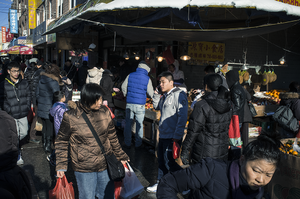Chinese emigration
| Chinese emigration | |

Typical grocery store on 8th Avenue in one of the Brooklyn Chinatowns (布鲁克林華埠) on Long Island, New York, USA. New York City's multiple Chinatowns in Queens (法拉盛華埠), Manhattan (紐約華埠), and Brooklyn are thriving as traditionally urban enclaves, as large-scale Chinese immigration continues into New York, with the largest metropolitan Chinese population outside Asia.
|
Waves of Chinese emigration (also known as the Chinese diaspora) have happened throughout history. The mass emigration known as the Chinese diaspora, which occurred from the 19th century to 1949, was mainly caused by wars and starvation in mainland China, invasion from various foreign countries, as well as the problems resulting from political corruption. Most immigrants were illiterate peasants and manual labourers, called "coolies" (Chinese: 苦力; pinyin: kǔ lì; literally: "Hard Labour"), who emigrated to work in countries such as the Americas, Australia, South Africa, and Southeast Asia.
According to Lynn Pan's book Sons of the Yellow Emperor, the Chinese coolie emigration began after slavery was abolished throughout the British possessions. Facing a desperate shortage of manpower, European merchants looked to replace African slaves with indentured labourers from China and India. A British Guiana planter found what he was looking for in the Chinese labourers: "their strong physique, their eagerness to make money, their history of toil from infancy".
Labour recruiters sold the services of large numbers of unskilled Chinese in the coolie trade to planters in colonies overseas in exchange for money to feed their families; this type of trading was known as Mai Zhu Zai (simplified Chinese: 卖猪仔; traditional Chinese: 賣豬仔; pinyin: mài zhū zǎi; literally: "Selling Piglets") to the Chinese. The labourers' lives were very harsh. Some labor recruiters promised good pay and good working conditions to get men signed onto three-year labor contracts. It was recorded on one pepper estate, fifty coolies hired, only two survived in half a year. Most coolies were treated badly, and many died en route to South America and South Africa because of bad transport conditions. Usually, they were cheated of their wages and were unable to return to China after their contracts expired.
...
Wikipedia
